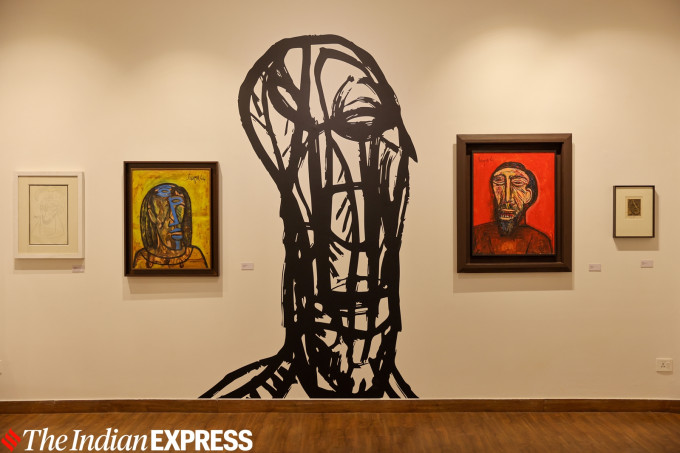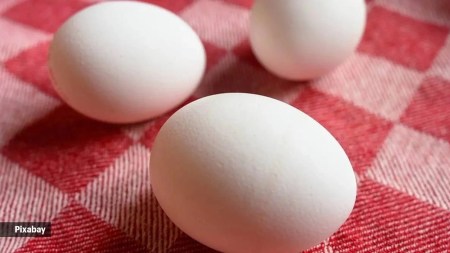Celebrating modern India’s best-known artist on his centenary: Who was FN Souza?
A large portrait of a couple, oil on canvas, catches your eye as you enter the Dhoomimal Gallery in Delhi for what surely is one of the largest and most comprehensive exhibitions in India featuring the works of Francis Newton Souza — the Goa-born artist of whom art historian and critic John Berger once famously said that he “straddles many cultures, but serves none”. So, it is not surprising that even 22 years after his death, Souza remains one of the best-known Indian modernists globally, with his trademark nudes and (distorted) faces being much sought after by collectors abroad.
Painted a day after Holi, following celebrations with hosts Uma and Ravi Jain, the portrait reflects a softer side of FN Souza, offering a glimpse into his personal life and relationships. “When Souza presented it to my parents, he explained that he had tried to capture my mother from the perspective he had been observing her from,” says Uday Jain, who has put up the mega show to celebrate the artist’s hundredth birth anniversary.

The exhibition, curated by art historian-author Yashodhra Dalmia, showcases over 150 works spanning Souza’s career, providing viewers with a chronological journey through his emotional and artistic evolution. Through this exhibition, viewers have the opportunity to trace Souza’s development, from a young, raw painter to a seasoned artist grappling with life’s challenges, all while leaving an indelible mark on the world of art.
 Souza remains one of the best known Indian modernists abroad. (Express photo: Khambhati Chitral)
Souza remains one of the best known Indian modernists abroad. (Express photo: Khambhati Chitral)
Interestingly, despite his larger societal concerns, Souza’s art remained deeply personal, often incorporating individuals close to him, including the women in his life. Souza’s art invites a sense of voyeurism into his personal life, shaped by his tumultuous relationships and experiences. From his early days of drawing controversial sketches to his later works reflecting his battles with illness, each piece offers insight into the artist’s inner world.
In the 1940s, his art exuded rebellion and aggression, characterised by vigorous lines and a raw energy evident even in his landscapes of Portuguese Goa. His fascination with human anatomy, evidenced by his study of surgical tomes and dissection of cadavers, underscored his preoccupation with the human form. Transitioning into the late 1950s and 1960s, Souza’s confidence as an artist grew alongside his international recognition and personal contentment. His works from this period display a softer touch in depicting heads, yet maintain a strong and confident stroke that defines his trademark style. Notably, pieces like Birth and Lovers garnered high prices on the international market, reflecting the favor towards Souza’s works from this era.
However, by the 1960s, Souza’s personal restlessness resurfaced amid marital struggles and a move to New York. This inner turmoil found expression in his art, characterised by angry lines and distorted figures, mirroring his own questioning and dissatisfaction with societal and personal changes.
 The exhibition showcases over 150 works spanning Souza’s career. (Express photo: Khambati Chitral)
The exhibition showcases over 150 works spanning Souza’s career. (Express photo: Khambati Chitral)
In the 1970s, Souza’s art took on softer themes, reflecting a happier frame of mind marked by a new marriage and the birth of a child. Yet, by the 1980s, he reached the peak of his authority as an artist, with his strokes appearing less angry and distortions serving as a stylized element rather than a reflection of inner turmoil.
Towards the mid-1990s, Souza grappled with the theme of death as he battled illness, resulting in poignant works like Pieta depicting deep anguish and religious imagery. Despite his rebellious nature, Souza’s connection to his Goan and Catholic roots remained strong throughout his artistic journey, illustrating the enduring influence of his upbringing and heritage.
Uday, also the director of Dhoomimal Art Gallery, highlights Souza’s unparalleled contribution to the art world: his fearless approach to painting. Jain emphasises that Souza defied traditional norms by eschewing conventional subjects like pretty figures, nudes, flowers, or landscapes. “No ‘pretty’ figures or nudes or flowers or mountains; what he painted wasn’t traditionally accepted till then in Indian art. He was courageous,” Jain tells indianexpress.com.
The exhibition is on at Dhoomimal Gallery, G42, Connaught Place, Delhi till 30 March, 11am-7pm (closed on Sundays)
Disclaimer: The copyright of this article belongs to the original author. Reposting this article is solely for the purpose of information dissemination and does not constitute any investment advice. If there is any infringement, please contact us immediately. We will make corrections or deletions as necessary. Thank you.





